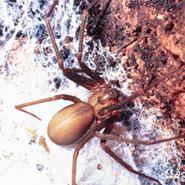
James O. Howell- University of Georgia www.insectimages.org
Brown Recluse
Loxosceles recluse
Known primarily for the flesh-eating properties of its venom, the brown recluse is a uniform brown color and can be identified by the dark brown, violin-shaped pattern violin that surrounds its six eyes. Fear of the brown recluse bite often leads people to wrongly identify other benign spiders as brown recluse. The brown recluse spider is often encountered hiding in cool dark places during the day -such as inside folded clothes or under logs- but is most active at night. This spider is not aggressive and usually only bites when accidentally pressed against human skin.
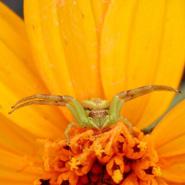
NPS Photo/Blake Trester
Flower Crab Spider
Misumenops celer
The coloration of the flower crab spider varies greatly, ranging from white to yellow, or even a bright green. Male flower crab spiders have red markings along the outer edge of their bodies and small bands of red on their two front legs. The front legs of the female are lighter in color and lack the red markings. Flower crab spiders are commonly found in cotton plants, and on certain cactus flowers.
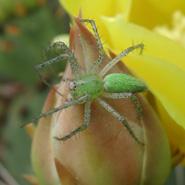
NPS Photo/Blake Trester
Green Lynx Spider
Peucetia viridans
Named for the bright green color of its body, the green lynx spider can be found hidden among flower blossoms. The bright green color helps the green lynx to blend with its environment in order to stalk its small insect prey. The legs of the green lynx are more yellowish than the rest of the body and covered in short black spines. Spiderlings are bright orange immediately after birth. Female green lynx spiders tenaciously guard their straw-colored eggsacs, often constructing protective shelters out of scattered leaves. The eggsacs of the green lynx can contain from 150 to 600 eggs.
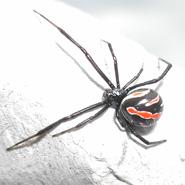
NPS Photo/Blake Trester
Southern Black Widow
Latrodectus mactans
Considered the most notorious spider in the United States, the Black Widow is actually timid and will attempt to escape danger before biting. This cobweb weaver prefers to build its web in shaded areas close to the ground. The juvenile form of the Black Widow is a yellowish white color. As it matures, this spider gradually turns black until only the distinctive hourglass mark remains on the lower abdomen. Males are usually smaller than females with longer legs, and they often exhibit a distinct white and black coloration.
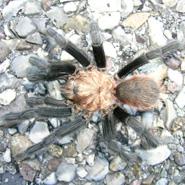
NPS Photo/Blake Trester
Tarantula
Aphonophelma spp.
Fairly common throughout the State of Texas, tarantulas are burrowing spiders that are easily identified by their large size. There are 14 species of tarantula found throughout Texas and specific identification is difficult even to those with the proper equipment, literature, and experience. However, some varieties from Northern Mexico are easier to identify due to their unique color pattern. Female tarantulas generally live longer than male tarantulas in Texas and can layfrom 100 to 1000 eggs in their burrows. Texas species of tarantula generally remain in burrows and their bite is not harmful to humans.
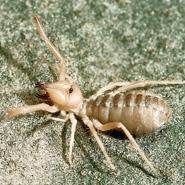
Kansas Department of Agriculture, Kansas State University www.pdis.org
Straight-Faced Solifugid
Family Eremobatidae
Also known as wind scorpions, straight-faced solifugids are characterized by their distinctive, vertically curved jaws. Unlike other scorpions, they are only able to walk on three pairs of legs, using their slender first pair as sensor organs. Though many people wrongly consider these nocturnal wind scorpions venomous, they lack venom sacks. They are, however, capable of inflicting a painful bite. Like spiders, males are generally smaller and have longer legs. Straight-Face Solifugids only live up to one year.
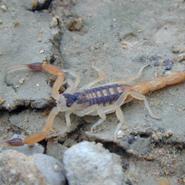
NPS Photo/ John Labadie
Striped Bark Scorpion
Centruroides vittatus
The striped bark scorpion can be recognized by two broad, black bands along the top of its abdomen. Color can vary from yellowish to light tan in adults of the species while younger striped bark scorpions are darker in color. striped bark scorpions mate in Fall, Winter, and Early Spring, and have a lifespan of up to four years. The sting of this scorpion causes swelling and localized pain.
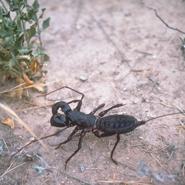
NPS Photo
Vinegaroon/Vinegarone
Mastigoproctus giganteus
The three-inch body of the vinegaroon makes it the largest known whip scorpion. Unlike other nocturnal creatures, the vinegaroon has poor eyesight and relies on its keen senses to feel vibrations and find its prey. Though it prefers a desert habitat it is also common in grasslands. The vinegaroon has no stinger, but its whip-like tail sprays an acidic solvent that can eat through the exoskeleton of other insects and smells remarkably like vinegar.
